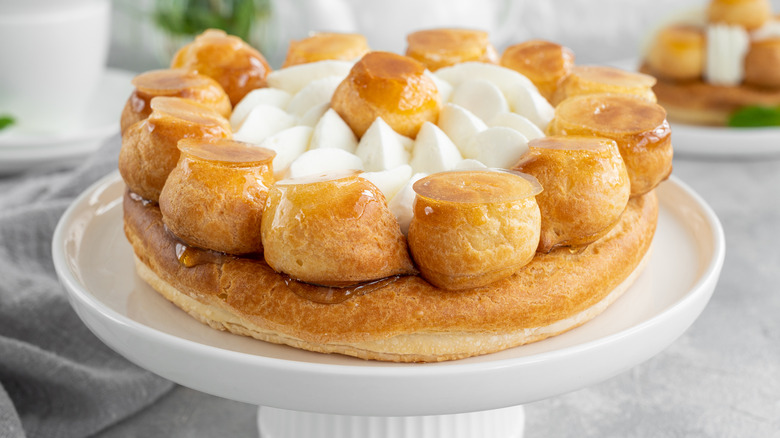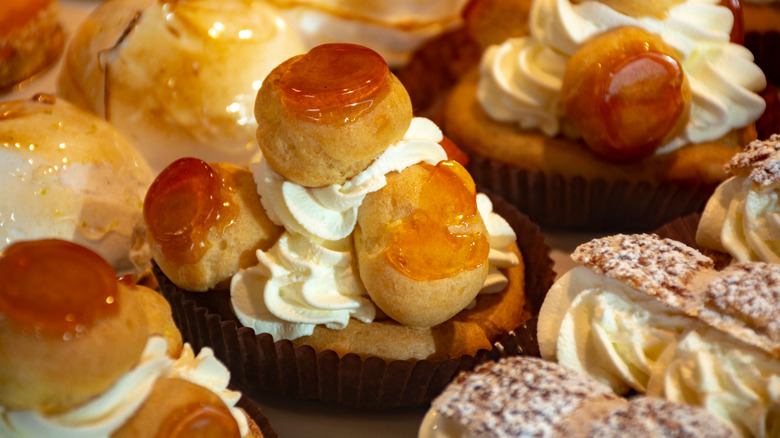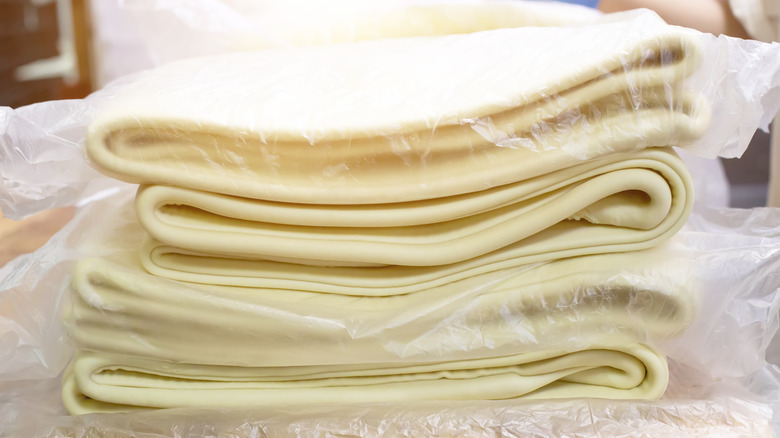The Complex French Puff Pastry Treat Named For Baking's Patron Saint
Pastry enthusiasts and fans of baking shows are well-aware of the slew of ornate French desserts that exist in the cafés and patisseries of Paris, each more elaborate and challenging to prepare than the last. If you're feeling a bit adventurous and want to try your hand at a dessert that incorporates multiple types of pastry and more than a little artistic flair, you might be eyeing the St. Honoré cake, or gâteau St. Honoré as it's called in French.
This dessert, which has been featured on "The Great British Bake Off" (aka "The Great British Baking Show," depending on which side of the pond you reside) by judge Prue Leith, is incredibly difficult to nail, even if you aren't on the clock and competing against other stressed bakers. It includes puff pastry, choux pastry, fresh caramel, Chantilly cream (a type of sweetened whipped cream), and crème Chiboust, a pastry cream with egg whites incorporated into it (via Only Crumbs Remain).
Origins of the St. Honoré cake
The St. Honoré cake was created in mid-19th century Paris by Fauvel Chiboust (the namesake of crème Chiboust), per So Good. The pastry chef's shop was on Rue Saint Honoré, a street known for its numerous patisseries and bakeries that got its moniker from the local chapel dedicated to Saint Honoré (via Gastro Obscura).
Honoré was the bishop of Amiens, a city in northern France, in the sixth century. Legend has it that once word of his appointment to this prestigious position reached his hometown, his former nursemaid refused to believe it unless her baker's peel (the wooden board used to take bread in and out of the oven) turned into a tree. As the story goes, when she put down her peel, it miraculously grew into a mulberry tree.
This, among other instances, contributed to Honoré eventually becoming known as the patron saint of bakers, confectioners, pastry chefs, flour merchants, and other artisans (via Catholic Online). Centuries after his death, his relics — which Encyclopedia Britannica describes as a saint's bones or belongings – were used in processions to end droughts and floods that could damage wheat harvests. And the chapel on Rue Saint Honoré was actually used as the headquarters for a baking guild in the 17th century (via NPR).
Honoré continues to be honored by the eponymous dessert and a feast on May 16 — a day to enjoy breads and pastries (via Bake Magazine).
Making a St. Honoré cake
Honoring a saint with pastry isn't simple! According to MasterClass, the gâteau takes over five hours to make. That's because puff pastry, just one of the components for this dessert, requires attention to temperature and takes two hours to chill. Another important part is the choux pastry — aka cream puffs. Bakers typically fill them by first slicing them in half or, as Prue Leith suggests, poking a hole on the bottom, and then inserting the cream with a piping bag. The filling itself is usually a pastry cream or crème Chiboust, which can be made with pastry cream and Italian meringue combined in a 2:1 ratio (via Gastro Obscura).
When assembling the St. Honoré cake, the bottom of each cream puff is gently dipped in caramel and placed in a ring on the puff pastry. After crème Chiboust is added to the center of the dessert, the cream puffs are topped with more caramel. As a finishing touch, Chantilly cream is used to decorate the middle.
All of this might seem too challenging and time-consuming to even attempt, but pastry chef Brigitte Malivert assured Gastro Obscura that making a St. Honoré cake is actually "doable" if it's just broken down into smaller steps.


